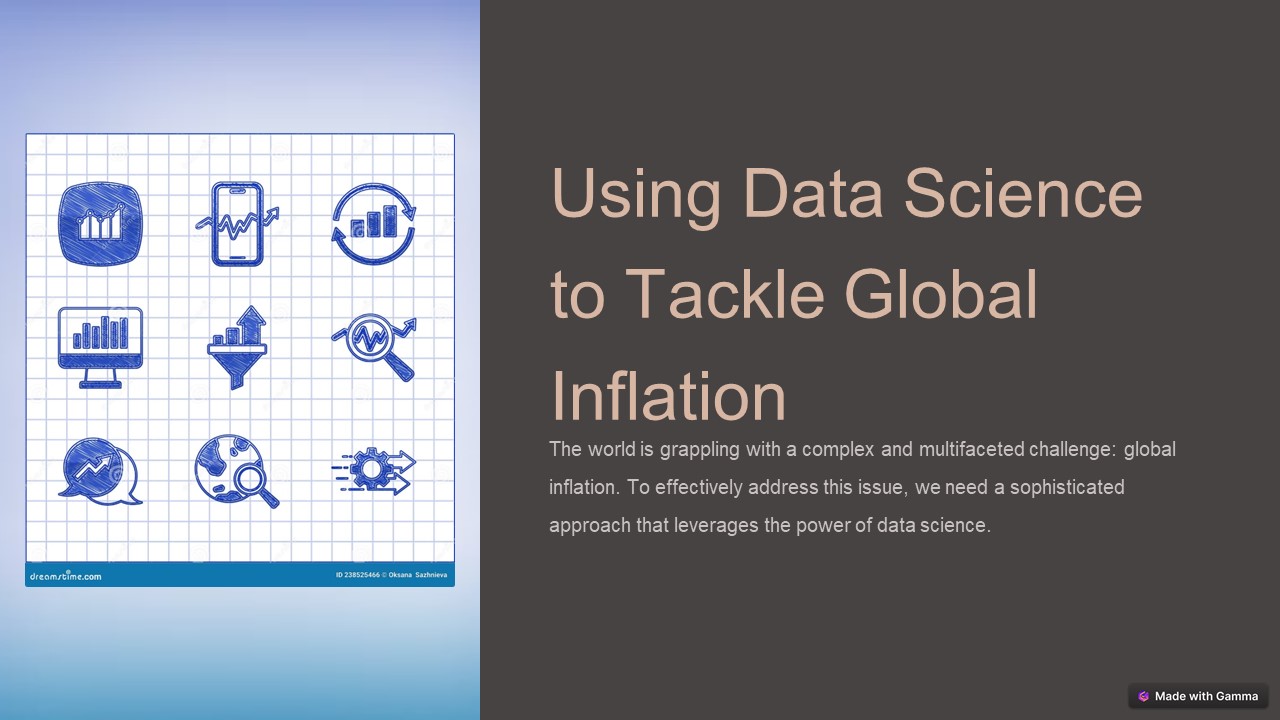Using Data Science to Tackle Global Inflation - PowerPoint PPT Presentation
Title:
Using Data Science to Tackle Global Inflation
Description:
Explore how data science is transforming the understanding and management of global inflation by analyzing economic indicators and trends. From predictive modeling to sentiment analysis, data science equips policymakers and economists with tools to make informed decisions in an evolving economic landscape. – PowerPoint PPT presentation
Number of Views:0
Title: Using Data Science to Tackle Global Inflation
1
Using Data Science to Tackle Global Inflation
The world is grappling with a complex and
multifaceted challenge global inflation. To
effectively address this issue, we need a
sophisticated approach that leverages the power
of data science.
2
Understanding Economic Indicators
Data science empowers us to analyze a wide range
of economic indicators, such as consumer price
index, inflation rate, and unemployment rate.
Consumer Price Index
Inflation Rate
1
2
Measures the average change over time in the
prices paid by urban consumers for a basket of
consumer goods and services.
Measures the percentage change in the price level
of a basket of goods and services over a period
of time.
Unemployment Rate
3
Measures the percentage of the labor force that
is unemployed and actively seeking employment.
3
Analyzing Inflation Trends
Analyzing historical inflation data can help us
identify patterns and trends, allowing us to
anticipate future inflation movements.
Historical Data
1
Historical inflation data provides insights into
past trends and patterns.
Trend Analysis
2
Statistical models are used to identify
underlying trends and patterns in inflation data.
Forecasting Models
3
Predictive models are used to forecast future
inflation based on historical trends and current
economic conditions.
4
Applying Data Science Techniques
Data science offers a diverse array of techniques
that can be applied to inflation analysis,
including statistical modeling, machine learning,
and deep learning.
Statistical Modeling
Machine Learning
Deep Learning
Linear regression, time series analysis, and
other statistical models can be used to identify
relationships between inflation and other
economic variables.
Machine learning algorithms can be used to
predict future inflation based on historical data
and current economic indicators.
Deep learning models can be trained on large
datasets of economic data to identify complex
patterns and relationships that are not easily
captured by traditional statistical models.
5
Identifying Drivers of Inflation
By analyzing economic data, we can identify the
key factors that are driving inflation, such as
supply chain disruptions, commodity price
increases, and demand-side pressures.
Factor
Description
Supply Chain Disruptions
Disruptions in global supply chains due to
factors such as pandemics, natural disasters, and
geopolitical tensions can lead to increased
prices.
Commodity Price Increases
Increases in the prices of raw materials, such as
oil and metals, can contribute to inflation.
Demand-Side Pressures
Strong consumer demand, fueled by factors such as
increased disposable income or low interest
rates, can drive prices upwards.
6
Forecasting Inflation Patterns
Data science enables us to build sophisticated
predictive models that can forecast future
inflation patterns with greater accuracy.
Model Development
Develop predictive models using historical
inflation data, economic indicators, and other
relevant variables.
Model Validation
Test the accuracy and reliability of the models
using historical data and comparing their
predictions to actual inflation outcomes.
Model Deployment
Deploy the validated models to generate forecasts
of future inflation trends.
7
Developing Data-Driven Policy Recommendations
By analyzing inflation trends and identifying
their drivers, we can provide data-driven policy
recommendations to policymakers.
Monetary Policy
Recommendations on interest rate adjustments,
reserve requirements, and other monetary policy
tools.
Fiscal Policy
Recommendations on government spending, taxation,
and other fiscal policy measures.
Supply Chain Management
Recommendations to improve supply chain
efficiency and resilience.
8
Conclusion Leveraging Data Science for
Sustainable Economic Growth
By effectively leveraging data science, we can
gain a deeper understanding of global inflation,
develop effective policy responses, and promote
sustainable economic growth. linkhttps//www.lear
nbay.co/datascience/chennai/data-science-course-tr
aining-in-chennai































